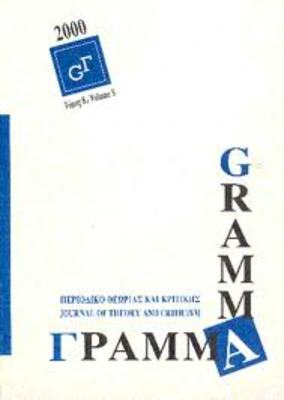The Difference Between Semiotics and Semiology
Part of : Γράμμα : περιοδικό θεωρίας και κριτικής ; Vol.20, 2012, pages 37-50
Issue:
Pages:
37-50
Author:
Abstract:
What is the relationship between semiotics and semiology? Received wisdomtells us that the “semiotics” of Charles Sanders Peirce largely overlapsin function and meaning with the “semiology” of Ferdinand de Saussure.Among semioticians more attentive to the nuances of each system, such asSebeok, Deely, and Eco, semiology occupies that part of semiotics whichrelates either to conventional communication, or intentional communication,or some other subset of semiotic acts. In this essay I aim to demonstratequite a different relation between the two fields of study. Drawingupon close readers of Saussure such as Harris and Weber, I will contrastsemiotics as an act of “representation” with semiology as an act of “articulation”.What I will propose is that semiotics and semiology form whollyseparate but contiguous domains of explanation.
Subject:
Subject (LC):
References (1):
- Barthes, Roland. Image Music Text. Trans. Stephen Heath. London: Fontana, 1977. Print.––. Mythologies. Trans. Annette Lavers. London: Jonathan Cape, 1972. Print.Critchely, Simon. The Ethics of Deconstruction: Derrida and Levinas. Oxford: Blackwell,1992. Print.Culler, Jonathan. Structuralist Poetics: Structuralism, Linguistics and the Study of Literature.Ithaca, NY: Cornell UP, 1975. Print.Daylight, Russell. What if Derrida was wrong about Saussure? Edinburgh: EdinburghUP, 2011. Print.Deely, John. Basics of Semiotics. Bloomington: Indiana UP, 1990. Print.––. “On ‘Semiotics’ as Naming the Doctrine of Signs”. Semiotica. 158.1 (2006): 1-33. Print.––. “The Word ‘Semiotics’: Formation and Origins”. Semiotica. 146.1 (2003): 1-49. Print.Eco, Umberto. A Theory of Semiotics. Bloomington: Indiana UP, 1976. Print.Eco, Umberto and Constantino Marmo, eds. On the Medieval Theory of Signs. Amsterdamand Philadelphia: John Benjamins, 1989. Print.Guiraud, Pierre. Semiology. Trans. George Gross. London: Routledge, 1975. Print.Harman, Gilbert. “Semiotics and the Cinema: Metz and Wollen”. Film Theory and Criticism:Introductory Readings. Ed. Leo Braudy and Marshall Cohen. Oxford: OxfordUP, 1998, 5th edition. 90-98. Print.Harris, Roy. Reading Saussure. La Salle, IL: Open Court, 1987. Print.Husserl, Edmund. Logical Investigations. Vol 1. Trans. J. N. Findlay. London, Routledge,1970. Print.Maras, Steven. “A Semiotics of the Proxy”. Social Semiotics. 12.1 (2002): 115-29. Print.Meier-Oeser, Stephan. “Medieval Semiotics”. The Stanford Encyclopedia of Philosophy(Winter 2003 edition). Ed. Edward N. Zalta. Web. http://plato.stanford.edu/archives/win2003/entries/semiotics-medieval/.Normand, Claudine. “System, Arbitrariness, Value”. The Cambridge Companion toSaussure. Ed. Carol Sanders. Cambridge: Cambridge UP, 2004. 88-104. Print.Ogden, C. K. and I. A. Richards. The Meaning of Meaning: A Study of the Influence ofLanguage upon Thought and of the Science of Symbolism. London: Kegan Paul,Trench, Trubner; New York: Harcourt, Brace, 1927. Print.Peirce, Charles Sanders. Collected Papers. Ed. Charles Hartshorne and Paul Weiss.Cambridge, MA: Belknap Press of Harvard UP, 1965. Print.Saussure, Ferdinand de. Cours de linguistique generale. Ed. Charles Bally and AlbertSechehaye with the collaboration of Albert Riedlinger. 2nd edition. Paris and Lausanne:Payot, 1922. Print.––. Course in General Linguistics. Ed. Charles Bally and Albert Sechehaye with thecollaboration of Albert Riedlinger. Trans. Wade Baskin. New York: PhilosophicalLibrary, 1959. Print.––. Course in General Linguistics. Ed. Charles Bally and Albert Sechehaye. Trans.Roy Harris. London: Duckworth, 1983. Print.Sebeok, Thomas A. Signs: An Introduction to Semiotics. 2nd edition. Toronto: U TorontoP, 2001. Print.Sless, David. In Search of Semiotics. Beckenham, Kent: Croom Helm, 1986. Print.Sturrock, John. Structuralism. 2nd edition. London: Fontana, 1993. Print.Weber, Samuel. Return to Freud. Trans. Michael Levine. Cambridge: Cambridge UP,1991. Print.––. “Saussure and the Apparition of Language: The Critical Perspective”. Modern Language Notes 91 (1976): 913-38. Print.




